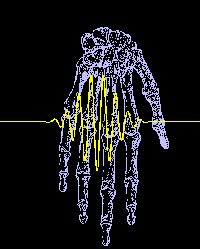Biomaterials Laboratory


Meet the Biomaterials Laboratory folks
Biomaterials Laboratory Publications
Osteoporosis is one of the most important diseases of aging, afflicting as many as 20 million Americans, and contributing substantially to morbidity and mortality in the elderly. We have developed a method for producing quantitative three dimensional images of bone mineral by solid state phosphorus magnetic resonance imaging. These images yield determinations of the true bone mineral density (true BMD, in grams per cubic centimeter) which are comparable in accuracy to or better than those measured by dual energy x-ray absorptiometry. The method uses no ionizing radiation, is inherently three dimensional in nature, and has the potential of providing biochemical information about the mineral (for instance, enabling the ability to discriminate new bone from mature, or synthetic calcium phosphate from host bone).
Bone mineral chemical composition changes in subtle ways as newly deposited mineral matures to its final form. Although the precise nature of bone mineral composition is still the subject of extensive debate, we are contributing to progress in this area. We have identified a chemically unique protonated phosphate ion in biological bone which is unlike similar ions found in any of the well characterized synthetic calcium phosphates that have historically been used as chemical models for bone mineral. This could lead to novel noninvasive magnetic resonance methodology for characterizing the mineral during growth, healing, or various disease processes. In a parallel vein, we are developing methods for characterizing the rate at which bone mineral is deposited by the use of fluoride as a tracer in conjunction with fluorine magnetic resonance.
We develop methods for characterizing synthetic materials which are used as implants for reconstructive surgery, such as the repair of bone with porous remodelable biological calcium phosphate ceramic devices. Our solid state phosphorus MRI imaging methods are able to highlight the implant in the presence of bone mineral (which is chemically very similar to the implant materials), and measure the amount present. Additionally, we are developing an MRI-compatible furnace which will for the first time permit the detailed in situ examination of porous ceramic implants as they form during high temperature processing.
Calcification in arterial plaques may have a protective effect in stabilizing plaques against rupture, but may also contribute to stress concentration and subsequent rupture of unstable plaques. Plaque calcification appears to have remarkable similarities to bone mineral, and is suspected of being subject to deposition and remodeling by the same mechanisms which operate on bone mineral. We therefore are able to study plaque calcification with the same magnetic resonance methods we use so fruitfully in bone.
We are designing very small RF coils that can be introduced into blood vessels by means of catheters. These coils may be used as transmitters and/or receivers. Their extremely close proximity to vessel walls, and to lesions such as atherosclerotic plaques, permits vastly improved signal to noise ratio for imaging and spectroscopy.
Download the following Adobe Acrobat poster to get a sampling of the work being done here.